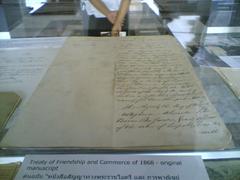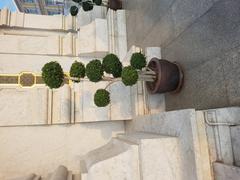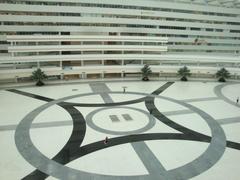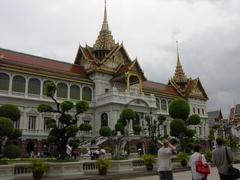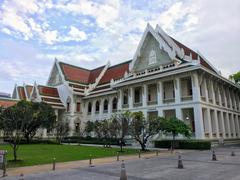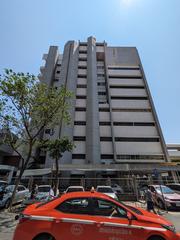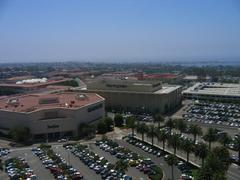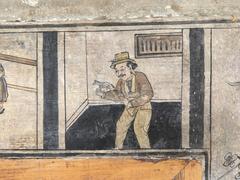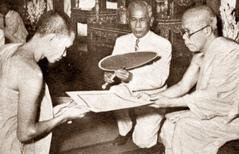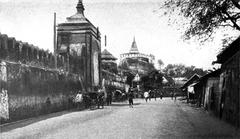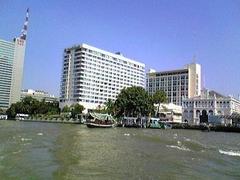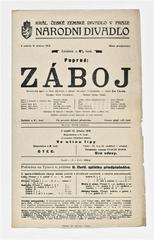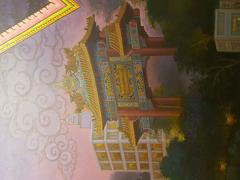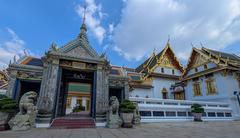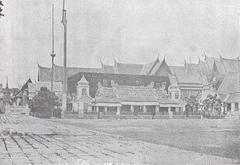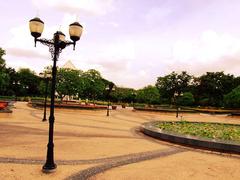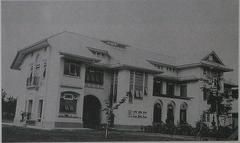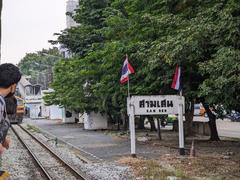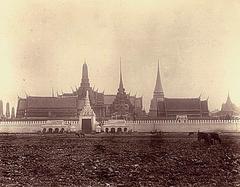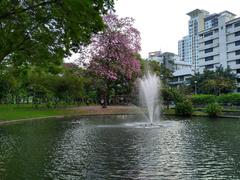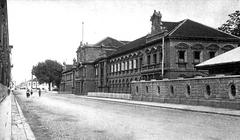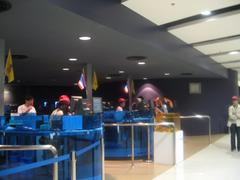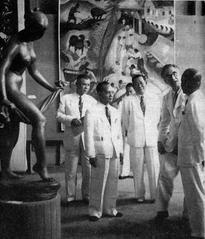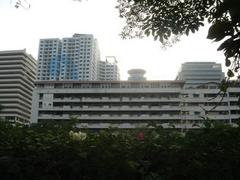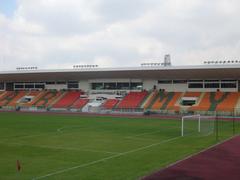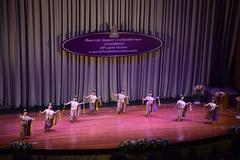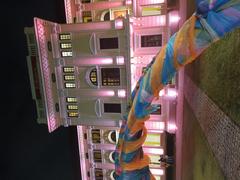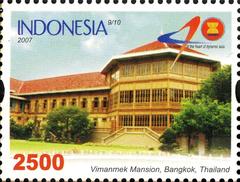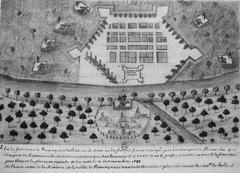Wat Suthat Thepwararam Ratchawaramahawihan Visiting Hours and Guide
Date: 18/07/2024
Introduction
Wat Suthat Thepwararam Ratchawaramahawihan, commonly known as Wat Suthat, is an exceptional emblem of Thailand’s rich cultural and religious heritage. Nestled in the bustling heart of Bangkok, this temple stands as a testament to the architectural and artistic brilliance of the Rattanakosin era. Its origins trace back to the early 19th century under the reign of King Rama I, the founder of the Chakri dynasty, who envisioned a grand temple to house the Phra Sri Sakyamuni, a colossal bronze Buddha statue originally from Sukhothai. The construction, completed during the reign of King Rama III in 1847, showcases the meticulous craftsmanship and the blend of Thai and Chinese architectural elements that define Wat Suthat (Tourism Thailand).
Wat Suthat’s significance extends beyond its architectural allure. It serves as a potent symbol of royal authority and religious devotion, reflecting the transformative period of the young Chakri dynasty. The temple complex also includes the Giant Swing, a towering red teak structure once central to Brahmin ceremonies, further enriching the site’s historical and cultural narrative (Bangkok.com). Today, Wat Suthat is a living legacy, offering a serene retreat for worshippers and an enlightening destination for tourists eager to delve into Thailand’s spiritual and cultural tapestry.
Table of Contents
- [Exploring Wat Suthat - History, Visiting Hours, and Travel Tips for Bangkok’s Iconic Temple](#exploring-wat-suthat---history-visiting-hours-and-travel-tips-for-bangkoks-iconic-templeexploring-wat-suthat-history-visiting-hours-and-travel-tips-for-bangkoks-iconic-temple)
- [Introduction](#introductionintroduction)
- [Historical Background and Significance](#historical-background-and-significancehistorical-background-and-significance)
- [Founding and Construction](#founding-and-constructionfounding-and-construction)
- [The Reign of King Rama III and the Temple’s Completion](#the-reign-of-king-rama-iii-and-the-temples-completionthe-reign-of-king-rama-iii-and-the-temples-completion)
- [A Symbol of Royal Authority and Religious Devotion](#a-symbol-of-royal-authority-and-religious-devotiona-symbol-of-royal-authority-and-religious-devotion)
- [The Giant Swing and the Brahmin Shrine](#the-giant-swing-and-the-brahmin-shrinethe-giant-swing-and-the-brahmin-shrine)
- [Wat Suthat Today - A Living Legacy](#wat-suthat-today---a-living-legacywat-suthat-today-a-living-legacy)
- [Visitor Information](#visitor-informationvisitor-information)
- [Nearby Attractions](#nearby-attractionsnearby-attractions)
- [Conclusion](#conclusionconclusion)
- [FAQ](#faqfaq)
Exploring Wat Suthat - History, Visiting Hours, and Travel Tips for Bangkok’s Iconic Temple
Introduction
Wat Suthat Thepwararam Ratchawaramahawihan, often shortened to Wat Suthat, stands as a testament to the rich history and architectural prowess of Thailand. Its story is interwoven with the reign of King Rama I, the founder of the Chakri dynasty, and his successor, King Rama III, who oversaw its completion.
Historical Background and Significance
Founding and Construction
The temple’s origins can be traced back to the early 19th century, during the final years of the Ayutthaya Kingdom. King Rama I, after establishing Bangkok as the new capital, envisioned building a grand temple to house the colossal bronze Buddha statue known as Phra Sri Sakyamuni. This statue, originally located in Sukhothai, held immense religious significance and was brought to Ayutthaya centuries earlier.
Construction of Wat Suthat commenced in 1801 under King Rama I’s reign. However, the ambitious project spanned several decades, finally reaching completion in 1847 during the rule of King Rama III. This extended construction period reflects the temple’s grandeur and the meticulous craftsmanship invested in its creation.
The Reign of King Rama III and the Temple’s Completion
King Rama III, known for his patronage of the arts and architecture, played a pivotal role in shaping Wat Suthat’s final form. He commissioned renowned artisans and craftsmen, ensuring the temple’s design embodied the finest elements of Rattanakosin art and architecture. The result is a harmonious blend of traditional Thai design with Chinese influences, evident in the temple’s intricate decorations and structures.
A Symbol of Royal Authority and Religious Devotion
Wat Suthat’s historical significance extends beyond its architectural splendor. Its construction served as a powerful symbol of royal authority and religious devotion during a period of significant change and consolidation for the young Chakri dynasty. The enshrinement of the revered Phra Sri Sakyamuni statue within the temple further solidified its status as a prominent religious center.
The Giant Swing and the Brahmin Shrine
Adjacent to Wat Suthat stands the iconic Giant Swing (Sao Ching Cha), a towering red structure made of teak wood. While not directly part of the temple complex, the Giant Swing holds a significant place in Thai history and tradition. It was erected in the 18th century and used in Brahmin ceremonies, reflecting the influence of Hinduism in Thailand’s past.
Although the swing ceremony is no longer practiced, the Giant Swing remains a prominent landmark and a reminder of Thailand’s diverse cultural heritage. Its proximity to Wat Suthat adds another layer of historical intrigue to the site, making it a captivating destination for those interested in exploring the intertwined threads of Thai history, religion, and architecture.
Wat Suthat Today - A Living Legacy
Today, Wat Suthat stands as one of Bangkok’s most important and impressive temples. It serves as a place of worship for locals and a must-visit destination for tourists seeking to immerse themselves in Thai culture and history. The temple’s serene atmosphere, intricate murals, and impressive architecture offer a glimpse into the artistic and spiritual heritage of Thailand.
Visiting Wat Suthat is like stepping back in time, allowing visitors to connect with the legacy of the Chakri dynasty and the enduring power of Thai Buddhism. The temple’s historical significance, combined with its architectural grandeur, makes it a truly unforgettable experience for anyone visiting Bangkok.
Visitor Information
- Wat Suthat Visiting Hours - The temple is open daily from 8:30 AM to 9:00 PM.
- Wat Suthat Tickets - The entrance fee for Wat Suthat is approximately 20 Thai Baht for foreigners. Admission is free for Thais.
- Travel Tips - Dress modestly when visiting the temple. Ensure shoulders and knees are covered. Photography is allowed, but be respectful of worshippers.
- Accessibility - Wat Suthat is accessible by public transportation, including buses and the MRT Blue Line (get off at Sam Yot Station). Tuk-tuks and taxis are also convenient options.
Nearby Attractions
- The Giant Swing - Located right next to Wat Suthat, it’s a must-see landmark.
- Wat Saket (Golden Mount) - Another historic temple nearby, offering panoramic views of Bangkok.
- Rattanakosin Exhibition Hall - Provides a deep dive into the history and culture of Bangkok.
Conclusion
Wat Suthat is more than just a temple; it’s a living legacy of Thai history, art, and spirituality. Whether you’re a history buff, an architecture enthusiast, or a spiritual seeker, Wat Suthat offers an enriching experience that connects you to the heart of Bangkok’s cultural heritage. Plan your visit today to explore this iconic temple and its surrounding attractions.
FAQ
What are the visiting hours for Wat Suthat?
- Wat Suthat is open daily from 8:30 AM to 9:00 PM.
How much are tickets for Wat Suthat?
- The entrance fee is approximately 20 Thai Baht for foreigners. Admission is free for Thais.
What are the nearby attractions to Wat Suthat?
- Nearby attractions include The Giant Swing, Wat Saket (Golden Mount), and Rattanakosin Exhibition Hall.
Conclusion
In conclusion, Wat Suthat stands as a monumental testament to Thailand’s historical, architectural, and spiritual heritage. Its intricate murals, grand structures, and serene atmosphere provide a unique window into the rich tapestry of Thai culture and Buddhism. The temple’s historical significance, coupled with its architectural grandeur, makes it a must-visit destination for anyone exploring Bangkok. From the majestic Phra Sri Sakyamuni Buddha image to the towering Giant Swing, every element of Wat Suthat tells a story of devotion, artistry, and history.
As a vibrant center of Buddhist practice, Wat Suthat continues to play a crucial role in the spiritual lives of many Thais, while also offering a tranquil escape for visitors. The temple’s ongoing preservation efforts ensure that future generations can continue to appreciate its beauty and significance. By visiting Wat Suthat, tourists not only immerse themselves in a rich cultural experience but also contribute to the preservation of this invaluable heritage site (Tourism Thailand). Plan your visit to Wat Suthat today and discover the timeless beauty and profound spirituality of this Bangkok treasure.
References
- Tourism Thailand. Wat Suthat Thepwararam Ratchaworamahawihan (Tourism Thailand)
- Bangkok.com. Wat Suthat (Bangkok.com)
